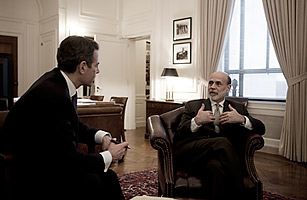
TIME's Managing Editor Richard Stengel talks with Federal Reserve Chairman Ben Bernanke during an interview in Washington, DC
Federal Reserve Chairman Ben Bernanke sat down on Dec. 8, 2009 with TIME managing editor Richard Stengel, Time Inc. editor-in-chief John Huey, TIME assistant managing editor Michael Duffy, and TIME senior correspondent Michael Grunwald for a conversation on everything from the state of the economy to the contents of his wallet. Here is an extended, edited transcript of the interview.
TIME: Explain for general-interest readers what it is that you do, and what it is that you've done during the past year that has impinged on their lives, for better, or for worse.
Bernanke: Well, I came to this job as an academic. I was a professor at Princeton University. And, in that capacity, I studied for many years the role of financial crisis in the economy. In fact, I became an expert on the Great Depression of the 1930s. It was a period in which the stock market crashed, and it collapsed the banking system. It was one of the main reasons that the economy was in such deep depression for more than a decade.
In 2002, I came to Washington to join the Federal Reserve as a member of the Board of Governors of the Federal Reserve. The Federal Reserve is the Central Bank of the U.S. It's an agency of the United States government, and it has a number of functions.
One important function is to set monetary policy, which means to change values of the short-term interest rate, to try to steer the economy to full employment and low inflation, to try and use that tool to keep the economy as stable as possible. But the Federal Reserve has some additional very important responsibilities. And one of the most important is trying to preserve stable transformance.
In fact, the Federal Reserve was created in 1913 in response to a severe financial crisis in 1907, with the objective of having an institution that could be a first responder to try to address situations where financial markets were in great disruption, great disarray before the effects on the economy were too great.
Importantly, in the 1930s, in the Great Depression, the Federal Reserve, despite its mandate, was quite passive and, as a result, financial crisis became very severe, lasted essentially from 1929 to 1933. And the effects on the economy we know. So, again, I came to Washington. I initially joined the Board of Governors, which is the group of seven leaders of the Federal Reserve who are appointed by the President, confirmed by the Senate.
I did that job for about three years. I then spent nearly a year in the White House advising the President on economic policy. And then in 2005, he appointed me to succeed Alan Greenspan as the chairman of the Federal Reserve. So, as the chairman of the Federal Reserve I am, essentially, the leader of this institution, and also of the committee that makes monetary policy, such as short-term interest rates, to address unemployment and inflation.
About a little more than two years ago, in the late summer of 2007, the financial sector of the U.S., and much of the world went into a period of significant stress. It was tied to excessive risk taking in much of the private sector. For example, many banks and mortgage brokers made sub-prime loans, which turned out to be bad loans, and those losses affected the banks and their perceived solvency from the perspective of the public and investors. But there were many other investments, also, that were made that were excessively risky, were dangerous, and brought losses to the financial system.
The stress on the financial system was in the fall of 2007, was significant, but not so significant as to threaten the overall stability of the U.S. economy, although it did lead to the beginning of a recession at the end of 2007.
[In response], I took a large number of steps, including cutting the short-term interest [rate], which is making monetary [policy] more supportive of the economy. By cutting short-term interest rates, we provided support for the economy to try and improve economic conditions, try and create jobs, and try to overcome the effects of the crisis. But, unfortunately, things heated up considerably in the fall of 2008.
In September 2008, the two largest housing mortgage companies called Fannie Mae and Freddie Mac, which were government-sponsored enterprises, which hold hundreds of billions of dollars of mortgages, because of the losses they took on the mortgages, they essentially became insolvent, and the government had to take them over.
Following that, there was increasing distress in the financial sector as investors became more and more concerned about the stability of many of the largest financial institutions in the U.S. and Europe. And this broke into a full-blown depression era style financial crisis in September, when Lehman Brothers, a large investment bank, failed and created an enormous wave of fear and uncertainty throughout the financial markets.
At that point, virtually every large financial firm in the world was in significant danger of going bankrupt because of the money being withdrawn quickly from those firms. And we knew, and I knew — based on my experience as a scholar, based on my experience as a policy maker — I knew that if the financial system, the global financial system, were to collapse in the sense that many of the largest firms were to fail, and the financial sector essentially stopped functioning, that the implications of that for the global economy would be catastrophic, that it we would be facing, potentially, another depression of the severity and length of the depression in the 1930s. And this was not at all hypothetical. And only one firm failed; that was Lehman Brothers.